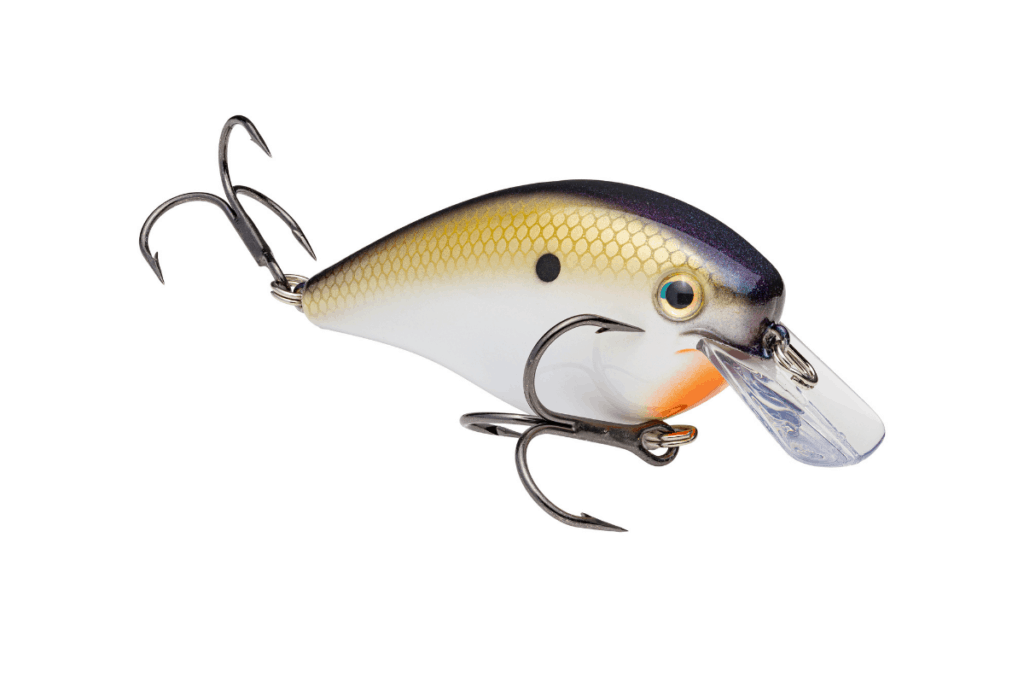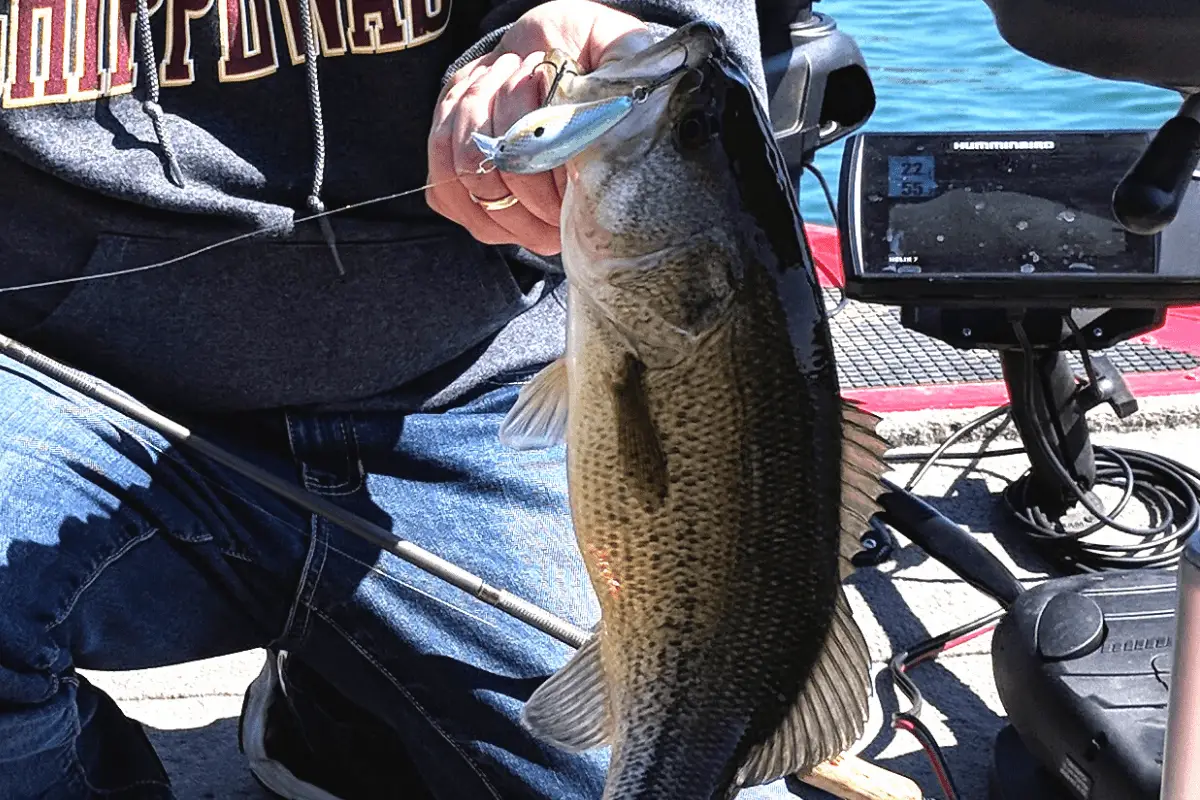Although a squarebill may fall under the “heading” crankbait, it is an entirely different lure with special attributes that make it an excellent fish searching tool.
Squarebill crankbaits have been predominantly used for targeting fish in shallow cover. Yes, this is an effective method for catching bass, but the squarebill is also a great crankbait for fishing in more open water and offshore situations. Its design not only bangs off cover, but it has a unique searching action that drives bass crazy.
History of the Squarebill
As far as popular legend goes, Fred Young has been credited with handing his special design to Rick Clunn in a tournament in the 1970s. Clunn, a legendary tournament angler that is till competing today, had never seen one before and tied one on as a courtesy to his partner.
Since that fateful event, Clunn experimented with the odd looking lure. He won a tournament on it in 1991 and the lure had a brief burst of popularity. He then finished 2nd with it in two consecutive events in 2000. Since then, the lure has been a mainstay in many tackle collections throughout the world.
Nearly every manufacturer that produces crankbaits offer some sort of squarebill lure – and they should.
As the popularity of this fish-catcher continues to grow, so do the variety of situations and techniques anglers use to bring bass to the boat.
Common Use
I love to say, “You can fish a squarebill anywhere you would fish a spinnerbait.”
It deflects and bounces off a variety of cover and elicits reaction strikes from shallow bass. I have crawled it up and over some of the nastiest brush, pounded it into rocks, and ripped it through vegetation. It is a true champion in all of those situations.
Because of this, the lure has been almost relegated to just a visible cover bait. Most anglers see a target and pitch or cast the lure to it. Just like they would when fishing a spinnerbait around shallow wood, rocks, and vegetation.
This works extremely well, but there is another use for this versatile lure.

Fishing a Squarebill Offshore
I don’t know exactly why, but the erratic action of a squarebill offers an uncanny ability to find fish. I have witnessed largemouth and smallmouth come rocketing out of the depths to smash one of these crankbaits as it wiggled and wobbled its way back to the boat.
I have spent a lot of time throwing one of these lures with ultra long casts to open water. The number of fish that I catch presenting the lure this way rivals what I would when fishing it in the more traditional style.
To make the most of your offshore squarebill fishing, there are a few key situations to think about. Find these and you have the recipe for success.
Presentation #1 – Paralleling
This has got to be my favorite way to fish this lure when not targeting visible cover. I parallel my boat with a shoreline and make as long of a cast as I can. I then bring that bait, fairly quickly, back to me.
Due to the variety of squarebill sizes, a range of depths can be targeted effectively. Most often I am hitting a target area somewhere between 5-10’. I spend a lot of time fishing lakes with heavy vegetation, so I often pick a lure that will just grab the tops of the grass, but, that is not needed. It will catch fish in open water.
I always start with a quick retrieve – almost burning the bait back to me. If that doesn’t grab a reaction I will then slow it down with an erratic start-and-stop presentation.
This paralleling method is so effective because the lure is in the perfect range for the majority of the retrieve. It is one of the most efficient methods that I know of to find bass.
Presentation #2 – Flats
When I was a young angler, flats intimidated me. These endless expanses of water that have little-to-no contour change made my anxiety flare up. The fish could be anywhere. Instead of finding an efficient way to investigate flats, I put the throttle down and moved on to something else.
I knew that bass love to get up on flats, especially when the spawn is on. They will often stay there clear through the bluegill breeding season, which is typically after the bass spawn.
A squarebill is a superb tool for exploring flats quickly.
It’s ability to bounce off cover and draw strikes in open water means that it is always working. Even when we cannot visibly see much variety out there on these flats. Fish often spread out on flats and a squarebill is a tool that can locate them in an efficient manner.
Presentation #3 – Points
Bass anglers know that points are excellent places to find fish through the entire year. There are also a wide range of lures that can be used on them with great success.
I like to use a squarebill to locate where the bass are using, and then if necessary, switch to another lure that may be a better choice to work the area thoroughly.
A point needs to be fished from multiple angles to locate those sweet spots. A squarebill’s ability to draw fish up in open water means that I have complete confidence in that lure, even when it loses contact with the bottom.
I can also position my boat offshore, inshore, or anywhere in-between and not need to pick up a different lure.
If I am sitting shallow and casting out to work the point from a different perspective, a deep diver will often hang-up as it moves towards the bank at this angle. A squarebill just keeps on chugging and has zero trouble working its way through ever increasingly shallower water.
Line Size
The most important difference when using a squarebill like this has to be the line size. If I am fishing it ultra-shallow at visible cover, most likely I have some pretty heavy line attached to the spool.
When I move to long casts and fish more open water, my go-to choice is 10lb fluorocarbon. This simple change allows the lure to get deeper and allow me to cover a variety of situations that can be controlled by how I hold my rod.
Sometimes I may reel the lure back with the rod tip actually down in the water and other retrieves may require I hold the rod tip up to work through a shallow area.
Rod and Reel for Squarebill Crankbait Fishing
I fish my crankbaits on rods designed for these lures. This will either be a glass model or a composite rod made with a glass and graphite mix.
A true cranking rod has more parabolic action to it with a slow taper. This allows for some flex when setting the hook. Crankbaits require steady pressure to keep those fish hooked and a rod that is too stiff will tear those trebles right away from them.
Most of the time I use a low-gear ratio reel when cranking, but this often is the one exception to that. As mentioned earlier, squarebills can be super effective with a quicker retrieve, so I find that I have success on a variety of gear ratios when using a squarebill.
Have Confidence
I can honestly say, when I started fishing squarebills in more open water, I often thought to myself, “this isn’t going to work.”
I made a few casts and then I put the setup down for a more traditional open-water selection. Then I made myself do it. I fished that thing, as i described in presentation #1, until I knew that it would do the job.
It’s funny how catching a fish or two on a new lure, presentation, or technique is all that is takes to keep it tied on.
It does work in these situations.
Final Thoughts
By no means, I a suggesting that you stop using a squarebill in the traditional sense. I know I won’t – but definitely consider using it when you run across the situations I mentioned above.
Paralleling with a squarebill can be a game changer.
Good luck out there, be safe, and don’t forget to encourage someone today. You never know how you might just change their life forever.

